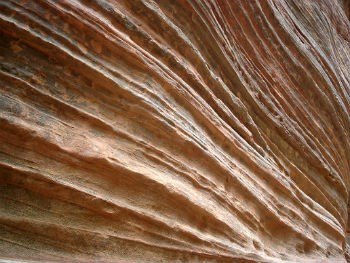
NPS photo/Adrienne Fitzgerald Where did all the sand come from?
By studying the orientation of cross-beds, geologists can determine the direction of ancient winds. Cross-beds in the Navajo Sandstone at Zion indicate that the dominant wind pattern during the Early Jurassic was from the north-northwest. A close look at the sandstone reveals fine, well-sorted, and well-rounded sand grains –evidence of a very long journey for this massive pile of quartz sand.
Geologists have looked even more closely at these rocks and found trace grains of the mineral zircon, which have helped to reveal the origins of the sand. These tiny, rare grains of zircon have enabled scientists to determine that at least some of the Navajo sand came from as far away as the ancient Appalachian Mountains, transported across most of North America by ancient rivers, and later blown by desert winds to the Colorado Plateau region.

Paleogeographic map courtesy of Ron Blakey, Colorado Plateau Geosystems, Inc.
Imagine the journey taken by each grain of sand –beginning as a crystal of quartz in a granite or quartzite in a mountain range as large as the modern Himalayas, eroding and being carried across the continent by extensive river systems to the northwest portion of North America, becoming rounded and refined along the way. Later, as climates dried, the sand was blown by the wind, tumbling and bumping along, finally to be dropped in the Colorado Plateau.
These sand grains were eventually cemented together, turning sand to solid stone. Later the sandstone (along with all the other sedimentary layers of the region) was lifted up thousands of feet, and exposed by the carving power of the Virgin River to now stand as the towering cliffs of Navajo Sandstone in Zion National Park! The future of each sand grain is inevitable –they are constantly eroding from these cliffs, working their way to the Virgin River, to start the cycle all over again…
Learn how sand dunes become sandstone Return to the Navajo Sandstone Return to the main Rock Layers page
|
Last updated: June 13, 2015
